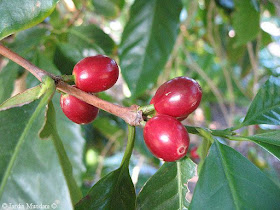The coffee plant belongs to the Coffea sort of the Rubiaceae family. Within the sort there is a total of ten species distributed by the south of Asia and subtropical Africa. The most cultivated is the Coffea arabica that is believed to be original of Ethiopia, although some botanists differ and locate its origin in Yemen. The coffee is an evergreen small shrub that gets to reach arboreal dimensions in wild state, surpassing sometimes the 15 meters of height. It prefers to grow in the shade of other trees.
It has been written much on this plant and I am not going to repeat it in this article. I want despite emphasizing two details less well-known than they have allowed it to proliferate extraordinarily of the hand of the man.
It has been written much on this plant and I am not going to repeat it in this article. I want despite emphasizing two details less well-known than they have allowed it to proliferate extraordinarily of the hand of the man.
Ripe fruits of cultivated Coffea arabica in the Botanical Garden of the Orotava in the Island of Tenerife.
I want to talk in the first place on the true purpose of the alkaloid caffein. Logically the coffee does not think about the man when synthesizing this stimulant. About which it really thinks is in defending itself of its main natural predators: the phytophagous insects. It is that caffein is a powerful insecticide that kills the arthropods that dare to eat their leaves, flowers and fruits. Being the most vulnerable parts the shoots and the flower buds on them concentrate more this powerful poison.
Coffea arabica branches laden with ripe fruits. I recommend to extend the photos to see better the details.
Also their seeds just germinated synthesize great amounts of this alkaloid with two purposes: first to protect the small plants of the phytophagous insectss and the second and much more surprising one to inhibit the germination of other seeds of coffee that can do the competition to it, so that the first seed that germinates inhibits to that it has close and thus a greater probability makes sure survival. Somehow the other seeds detect the high concentration of caffeine of their sister and they are sacrificed so that it can survive. If they germinated all the competition among them it would be so ferocious that in the end no would be able to reach the adult age and the species as a whole would leave losing.
Leaves of Coffea stenophylla. The leaves of all the species of coffee plant are green dark, shining, whole and ovate-lanceolate.
Gorgeous flower of Coffea stenophylla of an immaculate target that shines with own light. It is very similar to the flowers of another rubiaceae, the Gardenia thunbergia of South Africa.

Leaves and fruits of Coffea arabica photographed at the beginning of May in the Botanical Garden of Funchal in the Island of Madeira.
Green and ripe fruits of Coffea arabica.

Leaves and fruits of Coffea arabica photographed at the beginning of May in the Botanical Garden of Funchal in the Island of Madeira.
The second detail that I want to stand out makes also reference to the caffein, a stimulant that captivated the first humans who consumed its toasted fruits more ago than thousand years in the Arabic peninsula. This alkaloid synthesized to defend itself of the hungry of insects has allowed it to proliferate and to colonize all the tropical and subtropical regions of the Earth of the hand of the man, competing with other plants that also synthesize caffeine as tea, cocoa, mate, guarana, kola nut and holly of Yaupon.
In the end one is asked: who explodes to whom, who obtains more benefits, the coffee plant or the man. The answer is evident. Without the interested aid of the humans the coffee plant would follow confinated in its reduced origin regions. It would be a shrub more fighting to survive with the intelligent strategy to synthesize poison and to concentrate it in all the parts of its anatomy, from the roots to the leaves, flowers and fruits. Without wanting it, without a premeditaded natural planning, indeed it has been its poison that as much likes the humans which has turned to it into one of the worked plants more extended and numerous, calculating in about 15,000 million unit the total number of coffee plants that occupy more than 100,000 km2s of plantations. The operator apparently is the man, but the one that leaves winning is the coffee plant. The aromatic infusion of that they are consumed hundreds of million cups every day is one more a reward than sufficient for the man. To the coffee plant it does not matter to him to sacrifice 99´99% of its fruits if in return its survival makes sure on a large scale.





No comments:
Post a Comment